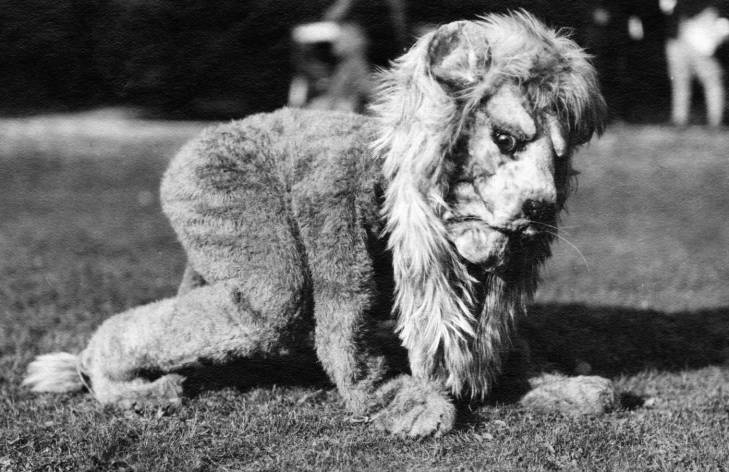The Nittany Lion is Penn State’s beloved mascot, “storied in song and legend.” It takes its name from Mount Nittany and the mountain lions that once roamed there and across Pennsylvania. Today, the Lion mascot is ubiquitous across campus for sporting, philanthropic, or any event that inspires the cheer “WE ARE … PENN STATE!”
The Nittany Lion mascot, as an idea, dates back to 1907, when Penn State third baseman Harrison “Joe” Mason coined the phrase “Nittany Lion” on a baseball team trip to Princeton. Confronted with the Princeton Tiger while touring the campus, Mason came up with an impromptu response to defend the team’s honor. He later recalled he told the Princetonians: “Well, up at Penn State we have Mount Nittany right on our campus, where rules the Nittany Mountain Lion, who has never been beaten in a fair fight. So, Princeton Tiger, look out!”
Penn State won that baseball game, and later, as editor of The Lemon, the college’s first humor magazine, Mason proposed the idea of the Nittany Lion as the college’s mascot. But there was confusion from the start about what kind of lion was intended. The 1907 La Vie (the Penn State yearbook), included a poem in its football section dedicated to “Old Nittany,” “the King of Pennsy State,” but the picture was of an African lion.

The confusion continued when the first “man in the suit” cavorted along the sidelines at a football game in 1921. Dick Hoffman, the first Nittany Lion mascot, borrowed a lion suit from a Penn State Thespians’ production of Androcles and the Lion and wore it at games until 1923. This African lion reappeared occasionally until 1927, but then was banished by football coach Hugo Bezdek for bringing bad luck to the team. The mascot did not reappear until 1939 – finally in the guise of a mountain lion.
However, as the years passed, the idea of the Lion mascot gained ground in publications and other venues. The “Nittany Lion,” one of the school’s most popular fight songs, written by Jimmy Leyden in 1914, was a feature of football games then (and now), but it was not until two physical manifestations of the lion arrived in 1939 and 1942 that the mascot became firmly established in college life.
Starting in the fall of 1939, at the request of Carl Schott, dean of the School of Physical Education and Athletics, gymnastics coach Gene Wettstone became the first man to don a mountain lion suit and perform “stunts” at pep rallies and football games. Following Wettstone, student gymnasts, and then students who tried out for the position took on the role. Gradually traditions evolved around the lion: students portraying the lion never wore the suit without the lion’s head on, or spoke while in the suit, always remaining anonymous through their career as the Lion.

The second manifestation is the sculpture of the lion by Heinz Warneke, known today as the Nittany Lion Shrine. The gift of the Class of 1940, the Lion statue was sculpted on the site by Warneke and his assistant. Just as with the Land-Grant Frescoes in Old Main, Warneke’s contract specified it had to be done in full view of students and they were permitted to ask him questions as he worked, so that this public art was an educational experience for all. The Nittany Lion Shrine was dedicated in 1942 with Mason as the keynote speaker, recounting the story of his idea and its consequences.
Where did Mason get his idea back in 1907? By then, mountain lions were extinct in Pennsylvania; Centre County’s last specimen was taken in 1893. However, there was a stuffed Pennsylvania Mountain Lion in the original Old Main museum that Mason passed by regularly. The so-called “Brush Lion” had been shot in 1856 in Susquehanna County, north of Scranton, by farmer Samuel Brush. Mounted by a doctor who was also an amateur taxidermist, the lion stayed at the Brush farm for thirty-some years, often being “ridden” by the farm children, before it was donated to the college for its natural history museum in 1890.
The Brush Lion was part of the college’s display at the Chicago World’s Columbian Exposition in 1893, and also spent several decades on display and in storage at the Carnegie Museum in Pittsburgh before it was finally returned to Penn State in 1996. After restoration, the “original Nittany Lion,” as it came to be called, was displayed in Pattee Library for several years. It was moved in 2011 to the Penn State All-Sports Museum in Beaver Stadium, where it is currently displayed.
Today, the Lion mascot at a Penn State football game is in his element, starting from the pre-game routines. He works with the cheerleaders rousing the crowd, does pushups after each score, and allows himself to be passed over the heads of the fans, hand-by-hand up through the stands. Over the years, the Lion has appeared at increasing numbers of athletic and philanthropic events as well. Everyone wants to be with the Lion, it seems, and thanks to televised football games, the Nittany Lion mascot became one of the best-known college sports mascots in the country.
Lee Stout
Sources:
Esposito, Jackie R. and Herb, Steven L. The Nittany Lion: An Illustrated Tale. University Park: Penn State University Press, 1997.
Stout, Lee and West, Harry H. Lair of the Lion: A History of Beaver Stadium. University Park: Penn State University Press, 2019.
First Published: September 16, 2021
Last Modified: February 17, 2025
